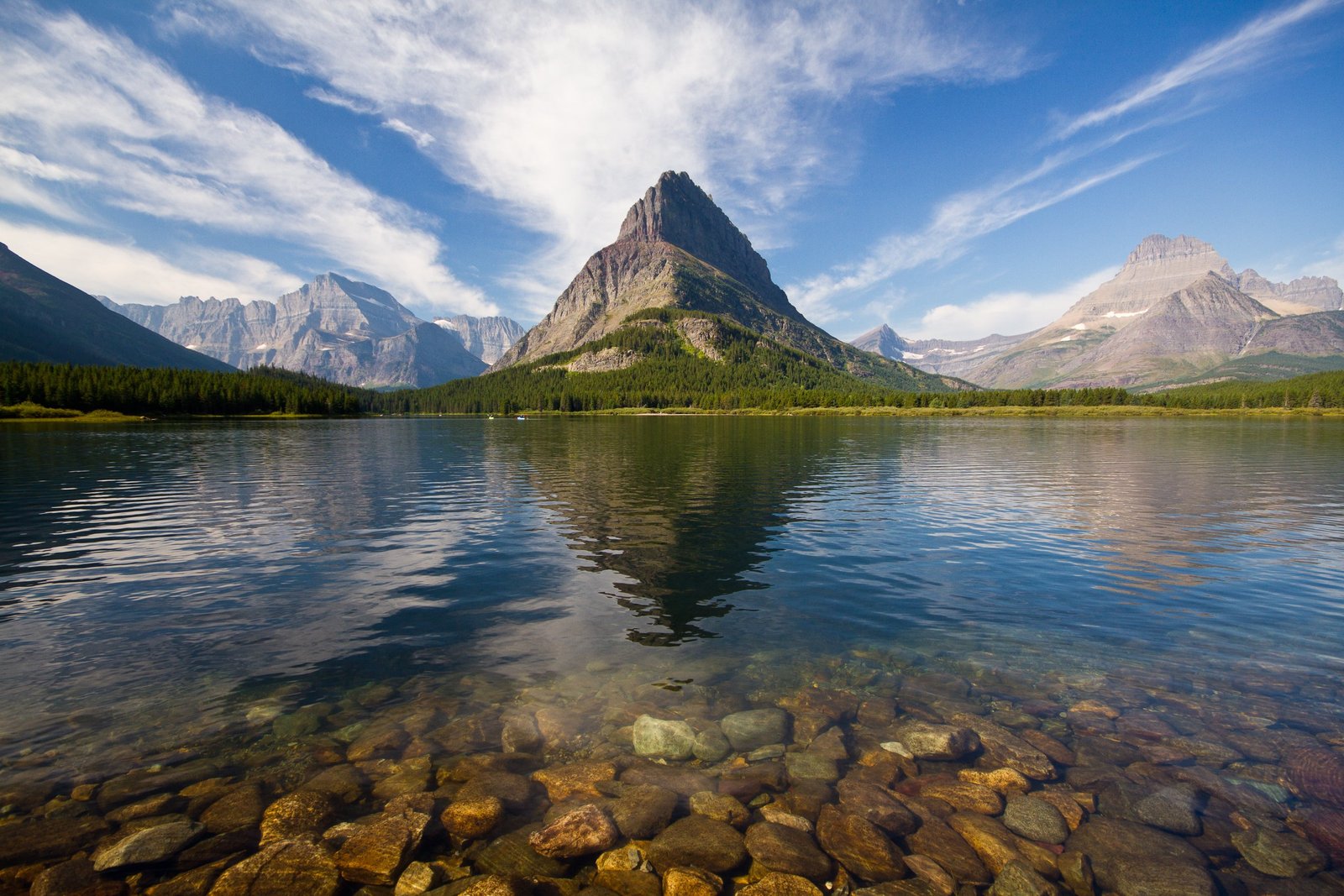The Iceberg Trail in Glacier National Park is a moderate to difficult hike, spanning 9.8 miles round trip with an elevation gain of 1,200-1,275 feet. This trail offers stunning views of old-growth forests, wildflower meadows, and the iconic Iceberg Lake. The difficulty level is influenced by its length, elevation gain, and potential wildlife encounters. Hikers should be prepared for varying weather conditions and carry essential gear, including bear spray.
What Makes the Iceberg Trail Challenging?

The Iceberg Trail presents several challenges that contribute to its difficulty level:
- Distance: At 9.8 miles round trip, this trail requires a significant time commitment and physical endurance.
- Elevation Gain: With 1,200-1,275 feet of elevation gain, hikers will experience a steady climb throughout the trail.
- Terrain Variety: The trail traverses through diverse landscapes, including forests, meadows, and rocky areas.
- Wildlife Presence: The area is known for grizzly and black bear activity, requiring constant vigilance and proper safety measures.
- Weather Variability: Conditions can change rapidly, necessitating proper gear and preparation.
How Does the Trail’s Difficulty Compare to Other Glacier National Park Hikes?

To put the Iceberg Trail’s difficulty in perspective, let’s compare it to other popular hikes in Glacier National Park:
| Trail Name | Distance (Round Trip) | Elevation Gain | Difficulty Rating |
|---|---|---|---|
| Iceberg Trail | 9.8 miles | 1,200-1,275 feet | Moderate to Difficult |
| Highline Trail | 11.8 miles | 1,950 feet | Difficult |
| Hidden Lake Overlook | 2.8 miles | 460 feet | Easy to Moderate |
| Grinnell Glacier | 10.6 miles | 1,840 feet | Difficult |
| Avalanche Lake | 4.5 miles | 730 feet | Moderate |
As we can see, the Iceberg Trail falls in the middle range of difficulty compared to other popular hikes in the park. It’s more challenging than shorter trails like Hidden Lake Overlook but less strenuous than the Highline Trail or Grinnell Glacier hike.
What Are the Key Sections of the Iceberg Trail?
Understanding the trail’s layout can help hikers prepare for its challenges:
- Trailhead to First Quarter Mile: This is the steepest section, with a 200-foot elevation gain in just 0.25 miles.
- Forest Section: After the initial climb, the trail levels out and winds through old-growth forest.
- Ptarmigan Falls: At about 2.5 miles, hikers reach Ptarmigan Falls, a popular rest stop.
- Open Meadows: Beyond the falls, the trail opens up into meadows with expansive mountain views.
- Final Approach: The last mile to Iceberg Lake involves some steeper sections and potential snow crossings.
What Gear Is Essential for Tackling the Iceberg Trail?
Given the trail’s difficulty and potential hazards, proper gear is crucial:
- Sturdy hiking boots
- Layered clothing (including waterproof layers)
- Bear spray (easily accessible)
- Plenty of water and high-energy snacks
- Trekking poles (optional but helpful)
- Sun protection (hat, sunscreen, sunglasses)
- First aid kit
- Navigation tools (map, compass, or GPS device)
- Emergency shelter (e.g., emergency blanket)
How Does Weather Impact the Trail’s Difficulty?
Weather conditions can significantly affect the Iceberg Trail’s difficulty:
- Summer: Generally the best time to hike, but afternoon thunderstorms are common. Start early to avoid peak heat and potential storms.
- Spring and Fall: Cooler temperatures and potential snow at higher elevations. Micro-spikes may be necessary.
- Winter: The trail is typically inaccessible due to snow and park closures.
Always check the latest weather forecast and trail conditions before setting out.
What Wildlife Precautions Should Hikers Take?
The presence of wildlife, particularly bears, adds an element of difficulty to the hike:
- Make noise while hiking to alert animals of your presence.
- Carry bear spray and know how to use it.
- Hike in groups when possible.
- Be aware of your surroundings and watch for signs of wildlife activity.
- Store food properly and pack out all trash.
How Can Hikers Prepare Physically for the Iceberg Trail?
Given the trail’s length and elevation gain, physical preparation is key:
- Cardiovascular Training: Engage in activities like hiking, running, or cycling to build endurance.
- Strength Training: Focus on leg and core exercises to prepare for the climb.
- Practice Hikes: Gradually increase the length and difficulty of your practice hikes.
- Altitude Acclimation: If coming from lower elevations, allow time to acclimate before attempting the hike.
What Are the Best Times to Hike the Iceberg Trail?
Timing can significantly impact your experience on the Iceberg Trail:
- Season: Mid-July to September typically offers the best conditions.
- Day of the Week: Weekdays are generally less crowded than weekends.
- Time of Day: Start early (around 7-8 AM) to avoid afternoon heat and thunderstorms.
How Long Does It Take to Complete the Iceberg Trail?
The time to complete the Iceberg Trail can vary based on fitness level and stops:
- Average Time: 5-7 hours round trip
- Faster Hikers: 4-5 hours round trip
- Slower Pace or More Stops: 7-8 hours round trip
Plan to spend at least 30 minutes at Iceberg Lake to rest and enjoy the views.
What Are the Trail Conditions Like?
Trail conditions can vary throughout the season:
- Early Season (June-early July): Potential snow patches, especially near the lake. Micro-spikes may be necessary.
- Mid-Season (July-August): Generally clear of snow, but can be muddy after rain.
- Late Season (September-October): Potential for early snow, cooler temperatures.
The trail is well-maintained and clearly marked throughout the season.
How Does Elevation Affect Hikers on the Iceberg Trail?
The elevation of the Iceberg Trail can impact hikers in several ways:
- Starting Elevation: The trailhead starts at about 4,900 feet above sea level.
- Ending Elevation: Iceberg Lake sits at approximately 6,160 feet.
- Altitude Effects: Some hikers may experience mild altitude symptoms like shortness of breath or headaches.
- Acclimatization: If possible, spend a day or two at similar elevations before attempting the hike.
What Are the Views Like Along the Iceberg Trail?
The Iceberg Trail offers a variety of scenic views:
- Forest Landscapes: Old-growth forests in the initial sections.
- Mountain Vistas: Panoramic views of surrounding peaks, including Mount Wilbur and Iceberg Peak.
- Wildflower Meadows: Especially vibrant in July and early August.
- Ptarmigan Falls: A beautiful waterfall about halfway through the hike.
- Iceberg Lake: The stunning turquoise lake with floating ice chunks (depending on the season).
How Crowded Is the Iceberg Trail?
The popularity of the Iceberg Trail can affect the hiking experience:
- Peak Season (July-August): Can be very crowded, especially on weekends and holidays.
- Shoulder Seasons: Less crowded in June and September, but weather can be more unpredictable.
- Parking: The Many Glacier parking area can fill up early on busy days. Arrive before 8 AM to secure a spot.
Consider hiking on weekdays or starting very early to avoid crowds.
By understanding these aspects of the Iceberg Trail’s difficulty level, hikers can better prepare for this challenging but rewarding experience in Glacier National Park. Remember to always check current conditions, follow park regulations, and practice Leave No Trace principles to preserve this beautiful trail for future generations.